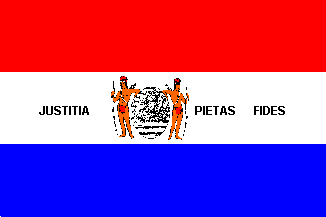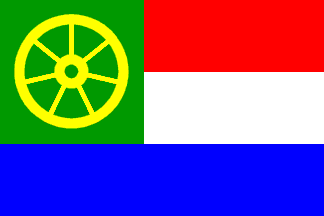
image by Mark Sensen , 19 April 1999

Last modified: 2021-08-25 by rob raeside
Keywords: suriname | guiana | dutch guiana |
Links: FOTW homepage |
search |
disclaimer and copyright |
write us |
mirrors
See also:

image by Mark Sensen , 19 April 1999
After the Kingdom of the Netherlands was established in 1815,
the arms of the kingdom were also valid for the colonies.
Nevertheless, the arms with the three-master can be found on
bank-notes and headings of gazettes, and also on a (unofficial?)
flag
Mark Sensen, 19 April 1999

image by Jarig Bakker, 31 January 2003
From "Vlaggenalbum" of Gouda's Roen (c. 1950) -
Doutful flag of Suriname with the Coat of Arms, and motto below
on a white scroll "JUSTITIA - PIETAS - FIDES . The central
shield is the same as on the Curaçao
doutful flag. The ship is of the West Indische Compagnie, see
<www.ngw.nl>
Jarig Bakker, 31 January 2003
Both Suriname and the Netherlands Antilles used the Coat of
Arms of the "Geoctrooiëerde Westindische Compagnie"
(Dutch West India Company), that is a three-master on a way sea.
So this Coat of Arms may have been used on flags. Note that the
old CoA at <www.ngw.nl>
has a white scroll with black lettering, and not a red scroll.
Jarig Bakker, 2 Febuary 2003
The flag with Coat of Arms should be seen on old photographs
or drawings - there were no colored photos then, but on a
tricolor the Coat of Arms should be visible. So I dived into the
archives. Most pictures have been made on holidays, and the flag
can be seen a lot of times. But there is no picture (period 1870
-1955) or drawing (period 16xx - 1900 ) where something can be
spotted on the white stripe. On very detailed drawings of the
fort Zeelandia one sees a tricolor without a trace of a Coat of
Arms.
So I came to the conclusion that it must have been an official
flag for Suriname, which had been designed in the Netherlands,
but never made it to Suriname. It also happened that the colonial
power wanted something, but the people in the colony did
something else. Communications were not quite perfect in those
days.
Phillip Lutz, 17 July 2003
![[1954-1975 Flag of Suriname]](../images/s/sr-1954.gif)
image by Mark Sensen, 25 March 2006
This is the flag of the Dutch overseas territory, introduced
when the status was changed from colony to OT (in 29 december
1954) and abolished after independence, in 25 november 1975.
Muller Harald, 31 January 1997, and Mark Sensen, 3
Febuary 1997
It was white with brown, white, red, black, and yellow stars.
All of which were connected by a black ring. The colors of the
stars represented the many different ethnic groups that make-up
the stock of the modern population while the ring symbolized
unity.
Calvin Paige Herring,1 June 1998
On a white field, a black ellipse bearing five white, black,
orange, red and yellow stars.
Ivan Sache, 31 January 1997
The black star stood for Creoles, the brown for the Asian
Indians, the yellow for the Chinese, the red for the American
Indians, and the white for the white Europeans.
Mark Sensen, 1 June 1998
At Sesam Encyclopedie (1977) - Suriname: Indeed an elips. The
stars are all pointing upward. Each star is outlined in black
(which is for the white star is quite essential on that white
field.
Peter Hans van den Muijzenberg, 30 September 2000
Here is the relevant text of the National Decree of 8 December
1959 (effective 15 December 1959) 'To Establish and Protect the
Flag of Surinam', together with part of the appendix:
Article One - The flag of Surinam shall consist of a rectangular
white field, charged with five black-bordered five-pointed stars
of equal shape and size, respectively in the colours black,
brown, yellow, red and white, interlinked by an elliptical black
band, both to conform with the description contained in the
appendix to this Decree.
Appendix:
1. General Characteristics
- 1a. The flag consists of a field rectangular in shape,
charged with five (black) bordered five-pointed stars of equal
size and shape, interconnected by an elliptical (black) band.
- 1b. Three of the five stars...
Translation from the original Dutch by Andre van de Loo.
Christopher Southworth, 30 January 2003
Wasn't it that the stars were pointing in different
directions? I.e. upper three stars were pointing outwards,
and lover two stars towards the center of the oval.
Željko Heimer, 2 Febuary 1997
According to the flag stamps issued by Surinam (Scott no.
282-283), all the stars seem to point upward.
ts0002@tw, 3 Febuary 1997
As you can clearly see the axis of the ellips determines the
position of the stars. In the Suriname society there was a lot of
discussion about the fact that the white star (the white people)
was top left. When hoisting the flag, so opponents said, the
whites pulled the coloreds upward - proving once again that the
whites were superior. There was also discussion about the
sequence of the stars. Everybody wanted to be on top. Discussion
was also provoked by the designer of the flag, Mr. Frank Essed, a
very dark colored Afro-Surinamer, who put the black star on top,
and who also an ardent nationalist.
Phillip Lutz, 17 July 2003
The flag of Suriname during colonial times (1954-1975 Dutch
Guiana as it was called for some time) with the five stars and
the ellipse as was shown on your page was not correct...the
position of the stars was not correct and stars were much bigger
Dave Abeleven, 25 November 2003
1954 is the year of the Statute of the Kingdom, but the flags
were not changed until 1966!
Mark Sensen, 14 April 2007
Previously Wrong Reported Flag

image by Calvin Paige Herring, 1 June 1998
![[1954-1975 Governor’s flag]](../images/s/sr-54-gv.gif)
image by Mark Sensen, 25 March 2006
The Governor flag was white with red, white and blue tribands
at the top and at the bottom. These bands symbolized the colonial
ruler of Suriname, the Netherlands. Centered on the middle white
field was a miniature version of the flag. When produced, only
the stars and ring appeared. There was no outline of a miniture
flag on the center white field.
Calvin Paige Herring, 1 June 1998
This flag was adopted by Order in Council of 14 March 1966,
together with a similar flag for the Governour of the Netherlands Antilles.
Mark Sensen, 1 June 1998
Concerning the governor's flag I do remember two things (I
couldn't find any photos to prove it): the flag with the three
white dots I saw indeed on the governor's "palace", and
also a flag with (on the place of the white dots) had Suriname
CoA, I think that that was because until 1963 Dutch people were
governors. In 1963 Currie, a "landskind" (black
Surinamer) was appointed as governor.
Phillip Lutz, 17 July 2003
1954 is the year of the Statute of the Kingdom, but the flags
were not changed until 1966!
Mark Sensen, 14 April 2007
See also: Overseas Governors (The Netherlands)

image by Mark Sensen, 21 september 1999
On the CD-ROM version of "Keesinghs Historisch
Archief" I found a proposal for a flag of Suriname in 1954:
the red-white-blue of the Netherlands, with on the red and white
at the hoist a green rectangle with in yellow a wheel with seven
spooks. The latter should represent both the seven districts and
seven communities.
I think the seven districts are: Paramaribo, Suriname,
Commewijne, Marowijne, Nickerie, Coronie en Saramacca; the seven
communities: Hindus, City-creoles, Javanese, Bush-creoles,
Indians, Chinese and Europeans.
Mark Sensen, 21 september 1999
The rejected proposed flag with the 7-spoked wheel in the
canton, had been earlier rejected - the wheel came from the
Hindustani corner and had been taken from the Indian flag.
Furthermote it was no "new flag", like most wanted, but
a Dutch flag with additions.
Phillip Lutz, 17 July 2003